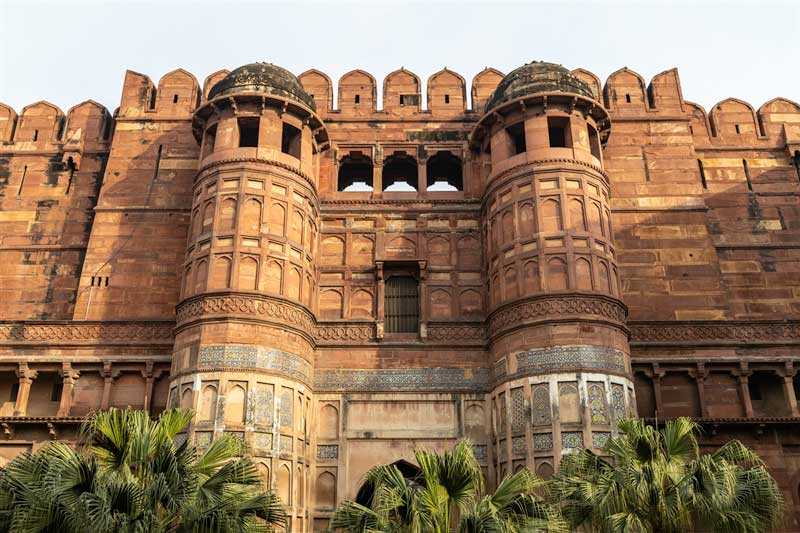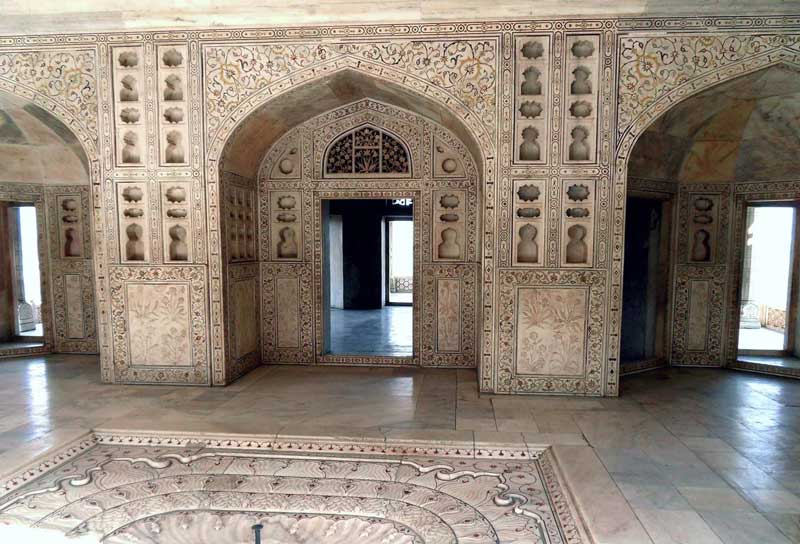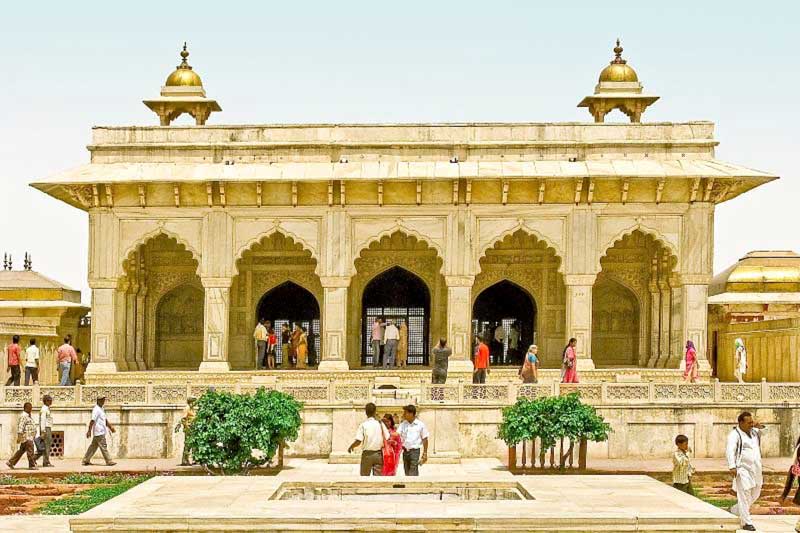
Located on the right bank of River Yamuna and about 2.5 km northwest of the Taj Mahal, the ivory-white marble mausoleum of Mumtaz Mahal, the favourite wife of the fifth Mughal Emperor Shah Jahan, the historic Agra Fort in the city of Agra served as the main residence of the rulers of the Mughal Dynasty until 1638, when the capital was shifted from Agra to Delhi. Reckoned as one of the UNESCO Heritage Sites since 1983 and representing one of the perfect examples of Mughal art and architecture, the massive fort is entirely made of red sandstone and contains several fairy-tale palaces within its 70 feet (21 m) tall and 2.5 km long enclosure walls. The beautiful buildings, located inside the fort complex and containing reminiscent of the Persian style architectural features, formed a city within a city.

Although the fort reflects a significant chapter in the history of India, its history before the invasion of Mahmud Ghazni is not clear. However, it was under the control of the Chauhan Rajputs, till Sikandar Lodi shifted his capital from Delhi to Agra and constructed a few buildings in the pre-existing fort at Agra. The fort, which was known as Badalgarh during those days, was held by his son Ibrahim Lodi for nine years, until he was defeated by Babur in the first battle of Panipat in 1526. Babur stayed in the conquered fort, in the palace of Ibrahim Lodi, for some time, built a baoli, a step well, in it and his successor, Humayun, was crowned in the fort in 1530. However, Humayun was defeated by Sher Shah Suri at Bilgram in 1540 and the fort remained in the control of the Suris till 1555, when Humayun recaptured it. But within a year, in 1556, Hemu, the general of Adil Shah Suri, recaptured Agra in 1556 and pursued its fleeing governor to Delhi where he met the forces of Mughal Emperor Akbar, led by Terdi Beg Khan in The Battle of Tughlaqabad on 7 October 1556. The Mughals were defeated in the battle and Hemu took possession of Delhi and also claimed royal status, assuming the title of Raja Hemchandra Vikramaditya. But it was a short lived victory as Hemu had to face a huge Mughal army at Panipat a month later, on 5 November 1556, led by Ali Quli Khan Shaibani in the centre, Sikandar Khan on the right and Abdulla Khan towards the left. In the historical battle, Hemu was wounded, captured and subsequently beheaded by the Mughal Emperor Akbar.

Akbar arrived in Agra in 1558 and realising the importance of its central situation, made it his capital and rebuilt the almost ruined the brick built Badalgarh with red sandstone from Barauli in Rajasthan. With the help of 4000 people, working day and night, the massive fort was completed in 1573. Nevertheless, the fort took on its current state during Emperor Shah Jahan, the grandson of Akbar, who demolished some of the earlier buildings inside the fort and tended to have buildings made from white marble. Unfortunately, Shah Jahan was deposed and imprisoned by his third son Aurangzeb in the Agra Fort from July 1658 till his death in January 1666 and it is said that he died in Muasamman Burj, a tower with a marble balcony with a view of the Taj Mahal.

Later, Agra Fort was under the Jat rulers for 13 years, who constructed the Ratan Singh Ki Haveli in the fort complex and captured by the Maratha Empire in the early 18th century. After that, it changed hands several times between the Marathas and others, until the Marathas were decisively defeated by Ahmad Shah Abdali at the Third Battle of Panipat in 1761. Finally, Mahadji Shinde, the Maratha ruler of Ujjain took the fort in 1785, to be lost to the British East India Company after the Second Anglo-Maratha War, in 1803.

The fort was originally provided with four gates on its four sides and apart from the Khizri gate opening towards the river, the others are Ghazni Gate, Delhi Gate and Lahore Gate. The majestic Delhi Gate, located on the western side of the fort, ornamented with intricate inlay works in white marble and considered the most imposing of the four gates, was built between1568-69, purposefully designed to enhance the security of the fort and served as the principal gateway of the fort. While a wooden drawbridge was used to negotiate the waterway of the moat, sharp 90 degree curves, trap points and paved ramps were devised to obstruct the way of any possible invasion. The Hati Pol or the Elephant Gate, an inner gateway, flanked by two life-size stone elephants, with their upturned trunks making an archway, added another layer of security. Unfortunately, only the pedestals of the sculptures can be seen today. The Lahore Gate, located on the western side of the fort, was possibly named as it faced the direction of Lahore. However, it was originally known as Akbar Darwaza and was reserved for the use of the Mughal emperor Akbar and his followers. The gate equipped with the same architectural traits and security arrangements as the Delhi Gate, also contains the imposing structure of the Naubat Khana, surrounded by pillared pavilions. Later, the gate was renamed Amar Singh Gate by Shah Jahan, after the brave Rao Amar Singh of Jodhpur, who killed Salabat Khan, the chief treasurer of Shah Jehan in front of him and in spite of surrendering, tried to commit suicide by jumping with his horse over the high walls of the fort. However, he failed in his attempt and was executed, but won the heart of the emperor for his commendable courage, who renamed the gate in his honour.

The huge complex of Agra Fort contains several magnificent structures constructed in different architectural styles, which mainly include Jahangiri Mahal, Khas Mahal, Musamman Burj, Sheesh Mahal, Diwan-I-Khas and Diwan-I-Am, along with three mosques namely, Nagina Masjid, Mina Masjid and Moti Masjid. However, the Jahangir Mahal, presumed to be the principal zenana palace belonging to the royal women and mainly used by the Rajput wives of Akbar, is perhaps the most important building in the Agra Fort constructed during the regime of Emperor Akbar. Located north of the Akbari Mahal and facing River Jamuna to the east, the palace was built in stone with Persian verses carved out beautifully in a large stone bowl used for storing rose water. However, the name of the palace is not connected to Akbar's son Jahangir, but a large bowl or tub, known as the Hauz-I-Jahangiri, which is located in front of its entrance portal.

Flanked by the lyrically flowing Yamuna on one side and the Anguri Bagh or the grape garden on the other, Khas Mahal, also known as Aramgah-I-Muqaddar, reflecting the later Mughal architecture, was built by Shah Jahan for his beloved daughters Roshnara and Jahanara. Devoid of windows, it has intricately perforated decorative stone screens, which present a fabulous view of the riverfront. It is believed that its marble screens were once adorned with flowers, created by precious gems. It is believed that the site of the Musamman Burj or the Octagonal Tower was once occupied by a small marble palace built by Akbar, which was later demolished by Jahangir to erect a new building for his favourite queen, the beautiful and powerful Mughal Empress Nurjahan. It is also presumed that later, Shah Jehan built the Musamman Burj or the Octagonal Tower on the same site for his beloved queen Mumtaz Mahal, offering a view of the Yamuna. Unfortunately, it was here, where Shah Jahan had to spend his last days, imprisoned by his son Aurungzeb, along with his favourite daughter Jahanara Begum.

The Sheesh Mahal, situated on the western side of the Musaamman Burj and considered one of the most exquisite constructions in the Agra Fort, was also constructed by Shah Jahan between 1631 and 1640, which was probably intended to be used as the royal bath. It has extra thick walls which were built to keep the interiors cool and pleasant, but its distinctive feature is the glass mosaic work on its walls and ceiling, which twinkles and glitters in a thousand ways in the semi-dark interior. Those glass pieces with high mirror quality were imported from Syria.


Located to the right of the Sheesh Mahal and constructed between 1631 and 1640, Diwan-I-Am or the Hall of Public Audience, evidences the earliest manifestation of Shah Jahan's affinity for marble. The huge assembly hall, measuring 201 feet by 67 feet, has two arched red sandstone gateways to the north and south, covered with white lime polished to a smooth finish. The famous Peacock Throne of the Mughal Emperor Shah Jahan was kept under the royal canopy, lavishly embellished with pietra dura ornamentation, using highly polished coloured stones. Another important building in the fort complex, the Diwan-I-Khas or the Hall of Private audience, located on the right of the Sheesh Mahal and also built by Shah Jahan between 1636 and 1637, is a rather small hall with double marble columns, inlaid with pietra dura decoration, where the emperor used to receive the important dignitaries. Open on three sides, it has five arched openings supported by double columns, but unlike the other architectural example of the era, it had no chhatris, the elevated, dome-shaped pavilions, over its parapet.

Apart from the above, the Agra Fort complex contains three mosques, constructed by Shah Jahan, namely The Moti Masjid, the Nagina Masjid and the Mina Masjid, among which the Moti Masjid is famous for its beauty. Located near the Diwan-I-Am, the beautiful Moti Masjid or the Pearl Masque is probably named for its pearly white marble interiors. It has three gates, decorated royally with beautiful arches and a few square chhatris. The prayer hall of the mosque is equipped with an arcade of seven elegant arches and the Mehrab on the western wall is engraved with six niches, in concurrence with the relative arches. The main prayer hall of the mosque has a marble screen with latticework, separating the women’s section. The Nagina Masjid, located near the famous Moti Masjid and constructed only for the ladies of the royal family, was made of pure white marble and crowned with three majestic domes, while the Mina Masjid or the Heavenly Mosque, also built entirely of white marble is surrounded by high walls. It is rumoured that Shah Jahan used the walled Mina Masjid during his last days when he was imprisoned in the Musamman Burj.